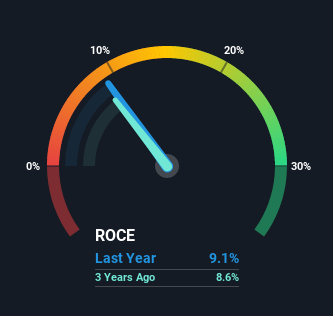If you're not sure where to start when looking for the next multi-bagger, there are a few key trends you should keep an eye out for. Ideally, a business will show two trends; firstly a growing return on capital employed (ROCE) and secondly, an increasing amount of capital employed. If you see this, it typically means it's a company with a great business model and plenty of profitable reinvestment opportunities. However, after investigating Huber+Suhner (VTX:HUBN), we don't think it's current trends fit the mold of a multi-bagger.
What is Return On Capital Employed (ROCE)?
If you haven't worked with ROCE before, it measures the 'return' (pre-tax profit) a company generates from capital employed in its business. To calculate this metric for Huber+Suhner, this is the formula:
Return on Capital Employed = Earnings Before Interest and Tax (EBIT) ÷ (Total Assets - Current Liabilities)
0.091 = CHF57m ÷ (CHF740m - CHF119m) (Based on the trailing twelve months to December 2020).
Thus, Huber+Suhner has an ROCE of 9.1%. On its own, that's a low figure but it's around the 10% average generated by the Electrical industry.
Check out our latest analysis for Huber+Suhner

In the above chart we have measured Huber+Suhner's prior ROCE against its prior performance, but the future is arguably more important. If you'd like to see what analysts are forecasting going forward, you should check out our free report for Huber+Suhner.
The Trend Of ROCE
Things have been pretty stable at Huber+Suhner, with its capital employed and returns on that capital staying somewhat the same for the last five years. It's not uncommon to see this when looking at a mature and stable business that isn't re-investing its earnings because it has likely passed that phase of the business cycle. So don't be surprised if Huber+Suhner doesn't end up being a multi-bagger in a few years time. With fewer investment opportunities, it makes sense that Huber+Suhner has been paying out a decent 47% of its earnings to shareholders. Unless businesses have highly compelling growth opportunities, they'll typically return some money to shareholders.
Our Take On Huber+Suhner's ROCE
In summary, Huber+Suhner isn't compounding its earnings but is generating stable returns on the same amount of capital employed. Although the market must be expecting these trends to improve because the stock has gained 73% over the last five years. However, unless these underlying trends turn more positive, we wouldn't get our hopes up too high.
If you want to continue researching Huber+Suhner, you might be interested to know about the 1 warning sign that our analysis has discovered.
If you want to search for solid companies with great earnings, check out this free list of companies with good balance sheets and impressive returns on equity.
If you decide to trade Huber+Suhner, use the lowest-cost* platform that is rated #1 Overall by Barron’s, Interactive Brokers. Trade stocks, options, futures, forex, bonds and funds on 135 markets, all from a single integrated account. Promoted
Valuation is complex, but we're here to simplify it.
Discover if Huber+Suhner might be undervalued or overvalued with our detailed analysis, featuring fair value estimates, potential risks, dividends, insider trades, and its financial condition.
Access Free AnalysisThis article by Simply Wall St is general in nature. It does not constitute a recommendation to buy or sell any stock, and does not take account of your objectives, or your financial situation. We aim to bring you long-term focused analysis driven by fundamental data. Note that our analysis may not factor in the latest price-sensitive company announcements or qualitative material. Simply Wall St has no position in any stocks mentioned.
*Interactive Brokers Rated Lowest Cost Broker by StockBrokers.com Annual Online Review 2020
Have feedback on this article? Concerned about the content? Get in touch with us directly. Alternatively, email editorial-team (at) simplywallst.com.
About SWX:HUBN
Huber+Suhner
Engages in the provision of electrical and optical connectivity components and system solutions.
Flawless balance sheet with solid track record.
Similar Companies
Market Insights
Community Narratives



